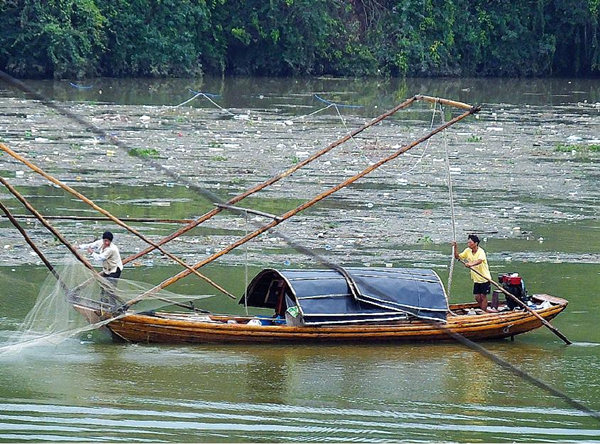River systems a challenge for China
 |
|
Garbage floating on the Yangtze River in Yichang, Central China's Hubei province. Pollution is a major problem for China's water supply. provided to china daily |
While China has begun to make progress in battling the smog that shrouds many of its major cities, the state of the country's river systems continues to get worse.
Late last year, China's Ministry of Environmental Protection said the quality of water in rivers, lakes and reservoirs in several regions has deteriorated significantly.
In November, the ministry published documents where its inspectors found 20 percent of the water in the Yangtze's feeder rivers in one province was unusable.
"We still have a lot of work to do," Vice-Minister Zhao Yingmin told a media briefing following the release of the documents.
"First, I would say the point of inspections is to discover problems, and indeed we discovered in some places water quality has gotten significantly worse but in other places the overall situation is improving," Reuters quoted Zhao as saying.
He said over the first nine months of 2016, 70.3 percent of samples taken from 1,922 surface water sites around China could be used as drinking water, up 4 percentage points from a year earlier.
Water has been a major problem for China, with per capita supplies less than a third of the global average.
Analysts say China faces the problem of trying to balance its water use between agriculture, which accounts for 65 to 70 percent of the country's water use, increased urbanization and energy supply, all of which compete for this limited resource.
Added to the mix is climate change, which already has an impact on water supply not only in China but throughout the region.
The government is now engaged in major engineering projects to pipe water from the south of the country to the drier north, including Beijing.
The central phase of the South-to-North Water Diversion Project opened two years ago, bringing water to Beijing via more than 1,200 kilometers of channels and pipes.
Some analysts say, however, that China cannot simply engineer its way out of its water crisis with headline megaprojects that will never be big enough to keep pace with increasing demand.
A study published in January 2015 in US journal Proceedings of the National Academy of Sciences warned that large-scale water transfers would actually exacerbate problems in the long run.
"China needs to shift its focus to water demand management instead of a supply-oriented approach," said the study's co-author, Dabo Guan, a professor at England's University of East Anglia.
"(China's) current transfer program is pouring good water after bad: The problems of water-stressed regions aren't being alleviated and the provinces sharing their water are suffering greatly," Guan said.
Pollution is another factor affecting water systems.
The Nature Conservancy in a report, Beyond the Source, published this month said water pollution can be reduced using "nature-based solutions (programs)" costing as little as $2 per person annually.
As Asian cities grapple with the immediate challenges of freshwater supply and pollution, threatening wide-ranging impacts on health, productivity and more, the conservancy has examined a series of low-cost, nature-based solutions that can benefit all stakeholders, "if managed via innovative water funds funded by diverse investors".
It cites a pilot program, the Longwu Water Fund in Huanghu county in East China's Zhejiang province. It is China's first such platform and combines a land trust with impact assessment, watershed conservation and sustainable farming.
The study also analyzed the source watersheds of more than 4,000 large cities around the world, including more than 1,800 in the Asia-Pacific region. It found that nature-based programs, such as reforestation and improved agricultural practices, can be implemented at a scale that makes a visible difference in sustainable development and improves the lives of billions of people.
"Cities in Asia Pacific and around the world stand to gain high returns from a modest investment in water protection, which can significantly reduce pollution in water sources with measurable results," the study said.
"For half of the cities analyzed globally, source water protection could cost just $2 or less per person per year."
The study found that four out of five cities it examined can reduce sediment and nutrient pollution by at least 10 percent through forest protection, pastureland reforestation and use of cover crops as an agricultural practice to improve water quality.
"Source watersheds collect, store and filter water and, when managed well, provide a number of additional benefits to people and nature.
"Protecting the land around our water sources is critical to ensuring our water supplies for the future," said Giulio Boccaletti, global managing director of TNC's water program.
"Unfortunately, 40 percent of source watershed areas show high to moderate levels of degradation.
"More than 30 percent of the area encompassed by urban source watersheds in Asia is highly modified by human development."
Globally, the report estimates that an increase of between $42 billion and $48 billion annually from the current $24.6 billion expenditure on watershed environmental service payment programs is required to achieve an additional 10 percent of sediment and nutrient reduction in 90 percent of source watersheds.
"With this level of funding, water security could be improved for at least 1.4 billion people by focusing on the most cost-effective watersheds for water security purposes," the report said.
"The cost of source water protection could be covered by revealing benefits to diverse payers through the business case for water funds.
"Water funds, which enable downstream water users to fund upstream land conservation and restoration, are highlighted as a successful mechanism for securing improved water quality and in some cases more reliable flows."
The report highlights that one in six cities, roughly 690 cities serving more than 433 million people globally, have the potential to fully offset conservation costs through water treatment savings alone.
Other cities can derive additional value from co-benefits and "stack" the total value to realize a positive return on investment.
The key nature-based solutions outlined by TNC's analysis and case studies include targeted land protection, revegetation, riparian (or riverbank) restoration, agricultural and ranching best management practices, fire risk management, wetland restoration and creation. Such methods preserve plant and animal biodiversity and build more resilient and healthy communities by protecting fisheries and improving farmland.
In April 2015, the Chinese government listed 16 pilot sponge cities, or water-sensitive cities. Over the next three years, the government will allocate each sponge city about 400-600 million yuan ($58-87 million) to develop ponds, filtration pools and wetlands; and build permeable roads that enable storm water to be absorbed.
















